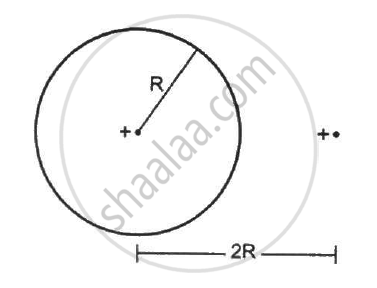Advertisements
Advertisements
प्रश्न
Use Gauss's law to find the electric field due to a uniformly charged infinite plane sheet. What is the direction of field for positive and negative charge densities?
Use Gauss's theorem to find the electric field due to a uniformly charged infinitely large plane thin sheet with surface charge density σ.
उत्तर
Electric Field Due to an Infinite Plane Sheet of Charge

Consider an infinite thin plane sheet of positive charge with a uniform surface charge density σ on both sides of the sheet. Let P be the point at a distance a from the sheet at which the electric field is required. Draw a Gaussian cylinder of area of cross-section A through point P.
The electric flux crossing through the Gaussian surface,
Φ = E × Area of the circular caps of the cylinder
Since electric lines of force are parallel to the curved surface of the cylinder, the flux due to the electric field of the plane sheet of charge passes only through the two circular caps of the cylinder.
Φ = E × 2A … (i)
According to Gauss' Theorem,
`phi=q/epsilon_0`
Here, the charge enclosed by the Gaussian surface,
q = σA
`:.phi=(sigmaA)/epsilon_0" ....(ii)"`
From equations (i) and (ii), we get:
`Exx2A=(sigmaA)/epsilon_0`
|
`E=sigma/(2epsilon_0)` |
The direction of an electric field for positive charge density is in outward direction and perpendicular to the plane infinite sheet. And for the negative charge density the direction of the field is in inward direction and perpendicular to the sheet.
APPEARS IN
संबंधित प्रश्न
An infinitely large thin plane sheet has a uniform surface charge density +σ. Obtain the expression for the amount of work done in bringing a point charge q from infinity to a point, distant r, in front of the charged plane sheet.
A point object is placed on the principal axis of a convex spherical surface of radius of curvature R, which separates the two media of refractive indices n1 and n2 (n2 > n1). Draw the ray diagram and deduce the relation between the object distance (u), image distance (v) and the radius of curvature (R) for refraction to take place at the convex spherical surface from rarer to denser medium.
A small conducting sphere of radius 'r' carrying a charge +q is surrounded by a large concentric conducting shell of radius Ron which a charge +Q is placed. Using Gauss's law, derive the expressions for the electric field at a point 'x'
(i) between the sphere and the shell (r < x < R),
(ii) outside the spherical shell.
Using Gauss’s law, prove that the electric field at a point due to a uniformly charged infinite plane sheet is independent of the distance from it.
A charge Q is uniformly distributed on a spherical shell. What is the field at the centre of the shell? If a point charge is brought close to the shell, will the field at the centre change? Does your answer depend on whether the shell is conducting or non-conducting?
A rubber balloon is given a charge Q distributed uniformly over its surface. Is the field inside the balloon zero everywhere if the balloon does not have a spherical surface?
Find the flux of the electric field through a spherical surface of radius R due to a charge of 10−7 C at the centre and another equal charge at a point 2R away from the centre in the following figure.

“A uniformly charged conducting spherical shell for the points outside the shell behaves as if the entire charge of the shell is concentrated at its centre”. Show this with the help of a proper diagram and verify this statement.
